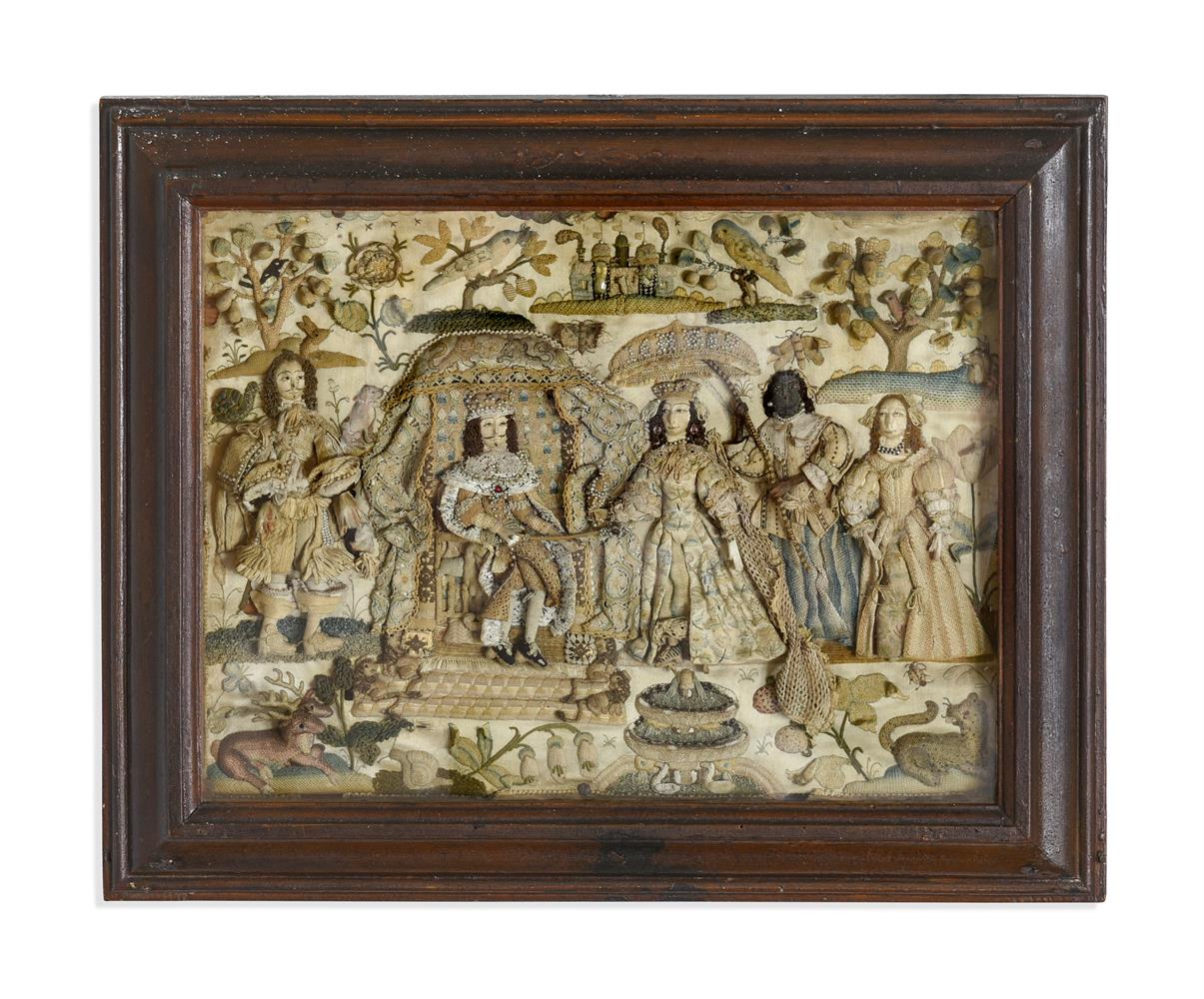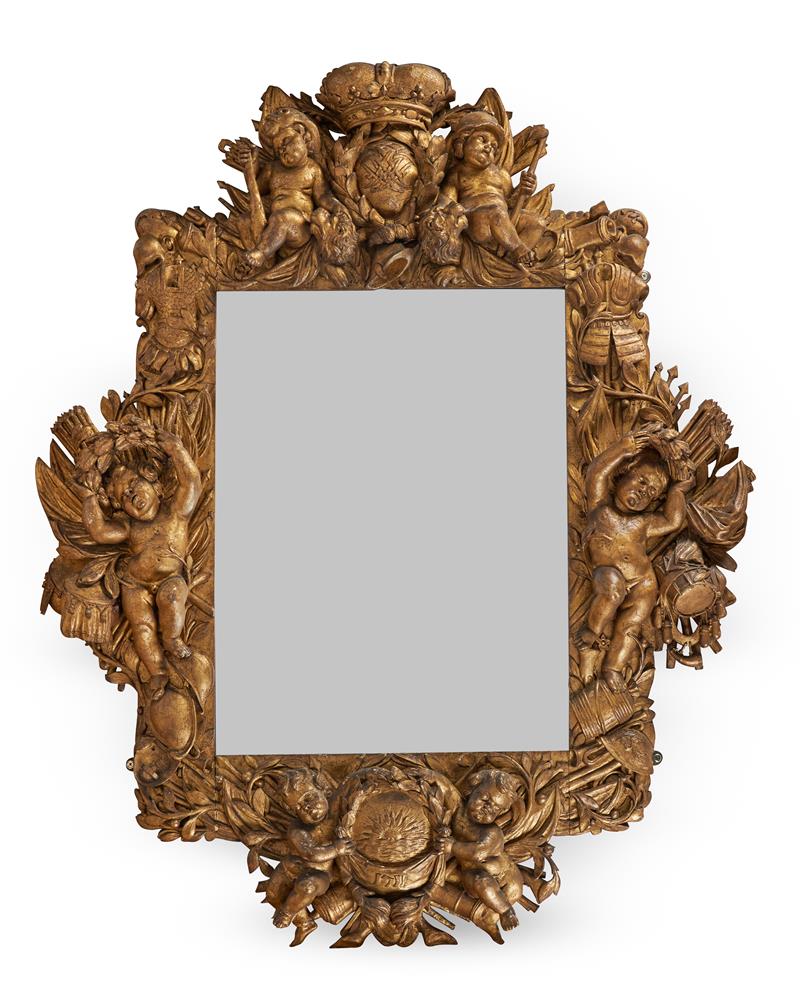A rare Charles II / William and Mary iron turret clock movement Probably attributed to Edward Hemins I, Biscester, circa 1680-90 The posted wrought-frame with elaborate spiral finials each resembling a Bishop’s crozier and splayed feet constructed with rectangular horizontal top and bottom frames with lapped screwed-tenon joints to the principal uprights at the angles, and subsidiary horizontal and vertical members creating frames for each train retained by conforming decorative nuts to the lapped joints, the trains laid out end-to-end opposing each other pivoted within brass bushes, with longitudinal barrels and 6.5 inch space between for a centre-swinging pendulum, the strike train centre bar stamped with a distorted forger’s mark, the three-wheel going train with four-spoke wheel crossings and brass escape wheel engaging with pallets set within a sub frame incorporating pendulum suspension and orb-outline finials, the barrel arbor with winding square opposing bevel gear and yoke to carry a pair of opposing dial take-off arbors, and lifting pin for the strike train set within the space between the trains, the strike train with countwheel cut with inernal teeth also occupying the space between the trains, twin arbor warning with hoop wheel and external large twin-vane fly with ratchet overrun set outside the frame over the barrel winding square, the frame also applied with remote hammer lever engaging with pins set into the rim of the greatwheel, (no pendulum and weights), the frame measuring 84cm (33ins) long by 69 (27ins) wide by 73cm (28.75ins) high. Details such as the design of the pallet sub assembly, distinctive form of the escape wheel crossings and screw collets securing the wheels onto their arbors can be compared to those on a turret clock by Edward Hemins II for Ditchley Park, Oxfordshire, circa 1722 (see Beeson, C.F.C. English Church Clocks 1280-1850 page 84 figure 51). This would suggest that the current lot was probably made in the same workshop but during the previous generation. Edward Hemins I is recorded in Loomes, Brian Clockmakers of Britain 1286-1700 as the father of the well-known lantern clock maker of the same name. Loomes notes Edward senior as a bellfounder and turret clock maker; two turret clocks by him are known, the first recorded by Beeson at Islip Church, the second made for Charlton-on-Otmoor in 1680, which is now housed in the Combe Mill Museum, Oxfordshire. The stamped forger’s mark (to the strike train centre bar) suggests that the iron bars used in the construction of the current lot were Swedish imports. Although distorted the mark appears to include a crown over a character suggesting that the foundry responsible for the iron was owned by a nobleman. Due to their use of charcoal in the production of wrought-iron (rather than coal) the Swedes produced the finest quality wrought-iron up until the Industrial Revolution, substantial quantities of which were imported into Britain during the 17th and 18th centuries (see Hildebrand, Karl-Gustaff SWEDISH IRON in the Seventeeth and Eighteenth Centurus, Export Industry before Industrialization page 18). Condition report disclaimer
A rare Charles II / William and Mary iron turret clock movement Probably attributed to Edward Hemins I, Biscester, circa 1680-90 The posted wrought-frame with elaborate spiral finials each resembling a Bishop’s crozier and splayed feet constructed with rectangular horizontal top and bottom frames with lapped screwed-tenon joints to the principal uprights at the angles, and subsidiary horizontal and vertical members creating frames for each train retained by conforming decorative nuts to the lapped joints, the trains laid out end-to-end opposing each other pivoted within brass bushes, with longitudinal barrels and 6.5 inch space between for a centre-swinging pendulum, the strike train centre bar stamped with a distorted forger’s mark, the three-wheel going train with four-spoke wheel crossings and brass escape wheel engaging with pallets set within a sub frame incorporating pendulum suspension and orb-outline finials, the barrel arbor with winding square opposing bevel gear and yoke to carry a pair of opposing dial take-off arbors, and lifting pin for the strike train set within the space between the trains, the strike train with countwheel cut with inernal teeth also occupying the space between the trains, twin arbor warning with hoop wheel and external large twin-vane fly with ratchet overrun set outside the frame over the barrel winding square, the frame also applied with remote hammer lever engaging with pins set into the rim of the greatwheel, (no pendulum and weights), the frame measuring 84cm (33ins) long by 69 (27ins) wide by 73cm (28.75ins) high. Details such as the design of the pallet sub assembly, distinctive form of the escape wheel crossings and screw collets securing the wheels onto their arbors can be compared to those on a turret clock by Edward Hemins II for Ditchley Park, Oxfordshire, circa 1722 (see Beeson, C.F.C. English Church Clocks 1280-1850 page 84 figure 51). This would suggest that the current lot was probably made in the same workshop but during the previous generation. Edward Hemins I is recorded in Loomes, Brian Clockmakers of Britain 1286-1700 as the father of the well-known lantern clock maker of the same name. Loomes notes Edward senior as a bellfounder and turret clock maker; two turret clocks by him are known, the first recorded by Beeson at Islip Church, the second made for Charlton-on-Otmoor in 1680, which is now housed in the Combe Mill Museum, Oxfordshire. The stamped forger’s mark (to the strike train centre bar) suggests that the iron bars used in the construction of the current lot were Swedish imports. Although distorted the mark appears to include a crown over a character suggesting that the foundry responsible for the iron was owned by a nobleman. Due to their use of charcoal in the production of wrought-iron (rather than coal) the Swedes produced the finest quality wrought-iron up until the Industrial Revolution, substantial quantities of which were imported into Britain during the 17th and 18th centuries (see Hildebrand, Karl-Gustaff SWEDISH IRON in the Seventeeth and Eighteenth Centurus, Export Industry before Industrialization page 18). Condition report disclaimer















Testen Sie LotSearch und seine Premium-Features 7 Tage - ohne Kosten!
Lassen Sie sich automatisch über neue Objekte in kommenden Auktionen benachrichtigen.
Suchauftrag anlegen